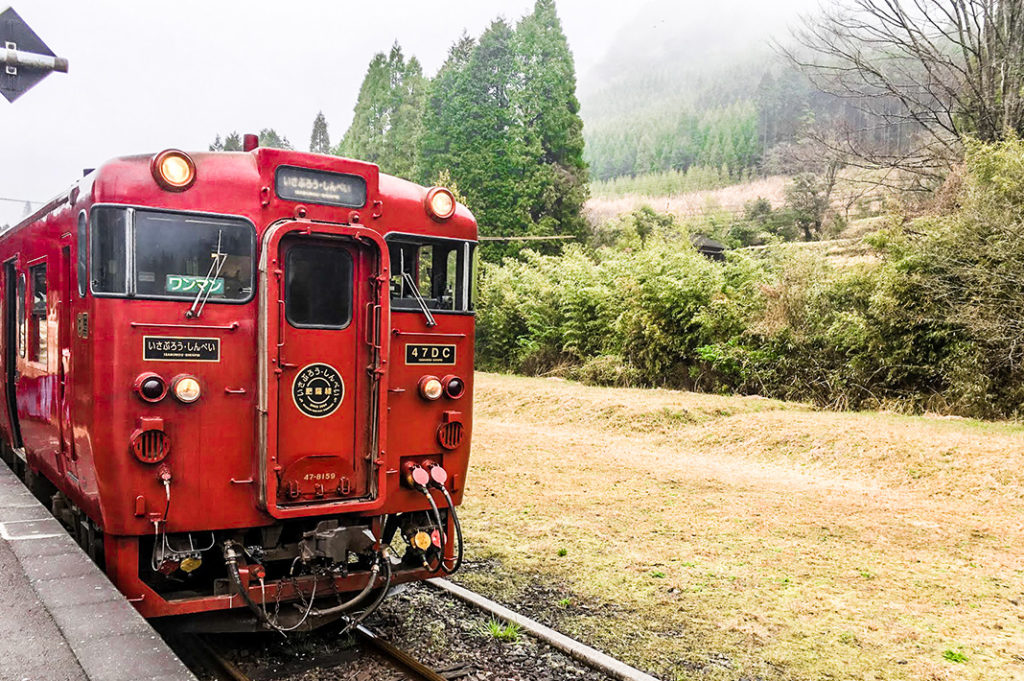Our last day of train travel didn’t disappoint. On the way down to Kagoshima, we rode the Isaburo-Shinpei line, which takes passengers on a trek through the forests and mountains of Kumamoto and Kagoshima prefectures. The dark wooden interior and primarily rural landscape of the Kirishima Mountains made the journey feel more like time travel than a train trip. After a few hours exploring the southern reaches of Kyushu, we arrived at the tip of the island and the end of our time on the train.
Isaburo-Shinpei line
The Isaburo-Shinpei train is named for two early Meiji era railroad entrepreneurs. It connects the towns of Hitoyoshi and Yoshimatsu, offering an antique atmosphere that recreates some of the Meiji-era decadence. You can book one of the plush upholstered seats in advance. However, if you’re traveling on a rail pass, as we were, you can simply use the benches lining the back without prior booking.

Regardless of your choice, you will get a good view of the mountains and forests. As the train moves higher and higher it moves through a series of switchbacks situated throughout the Kirishima Mountains. At several points along the journey, the train stops to point out distinct features of the landscape or give you a chance to stretch your legs. Be aware that the guidance is entirely in Japanese. However, enjoying the stunning vistas doesn’t require any level of linguistic proficiency.
Entering Kagoshima Prefecture
Onboard the Isaburo-Shinpei a sole female attendant made the rounds, catering to the five people onboard the train. With a tray strapped around her neck like a cigarette girl from the 1920s, she sold a series of items in quick succession. Starting with bento boxes, she moved on to postcards, and then toys. Nobody seemed to buy anything, but she carried on all the same. In between her rounds, she also pointed out interesting spots along the railway, and checked tickets. Her job seemed to be a busy and thankless one, but she carried it out cheerfully. After more than an hour aboard, she announced that we had entered Kagoshima.
While Kumamoto is made up of dense forests and tall mountain ranges, Kagoshima gets gradually warmer and more tropical the further south you go. As we left the Kirishima Mountains, the landscape began to become more volcanic and craters begin to pop into view.
End of the Line
We knew we were arriving in Kagoshima when palm trees began to spring into view. After a transfer in the town of Yoshimatsu, we bid goodbye to the Isaburo-Shinpei. We spent an hour wandering the town before boarding a more standard local train, and it took us the rest of the distance to Kagoshima. Large mountains sprung into view, and finally, the last of the large mountains gave way to a view of the ocean, and the volcanic island of Sakurajima came into view.
And that was it. The last day of train travel. We had travelled over a 1000 kms by rail. The small local trains had given us a view of the country we could never have gotten by bullet train or airplane, and we were grateful to have seen some locales off the beaten track. It was a little bit sad to give up our now routine days of box lunches and long stretches of reading, but as we made our way to our hotel we were excited for what would come next.
Destination: The Isaburo-Shinpei Line
Address: Nakaaoimachi, Hitoyoshi, Kumamoto Prefecture 868-0008
URL: https://www.jrkyushu.co.jp/english/train/isashin.html
Post by Japan Journeys.